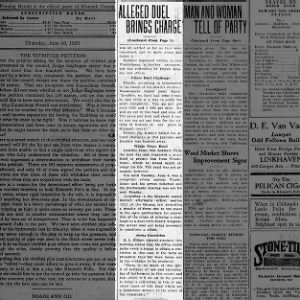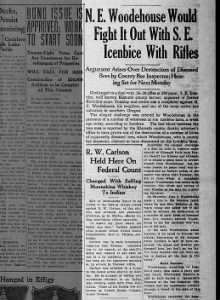
The Evening Herald Archive
- Klamath Falls, Oregon
- 1908–1942
About
In 1906, Fred Cronemiller and his wife launched a home-published newspaper, the Evening Herald, in the southern Oregon community of Klamath Falls, located just east of the Cascade Mountains. Two years later, Ed Murray and Wesley O. Smith bought the paper and, with the help of a linotype machine, turned the tabloid into a four-page broadsheet that ran every day except Sunday and cost five cents a copy. Murray and Smith had managed other papers in this town of 6,000 and sought to turn the Herald into the leading local newspaper.
In 1906, Fred Cronemiller and his wife launched a home-published newspaper, the Evening Herald, in the southern Oregon community of Klamath Falls, located just east of the Cascade Mountains. Two years later, Ed Murray and Wesley O. Smith bought the paper and, with the help of a linotype machine, turned the tabloid into a four-page broadsheet that ran every day except Sunday and cost five cents a copy. Murray and Smith had managed other papers in this town of 6,000 and sought to turn the Herald into the leading local newspaper.
At this time Klamath County was a growing area, as evidenced by the paper’s advertisements boasting cheap mill lots, the region’s livability, and a low incidence of malaria. In 1912, there were two other local dailies: the Klamath Falls Express and the Evening Chronicle. Both papers were purchased and then canceled by Sam Evans, who in that same year also started the Klamath Falls Northwestern, a morning daily, to rival the Evening Herald. The Northwestern lasted only three years, however, leaving the Herald as the only paper in Klamath Falls until 1923.
Though the Evening Herald was deemed conservative, it did not shy away from coverage that might have displeased area businesses. A 1913 headline blared, “Mine owners are blamed for panic,” and several articles between 1908 and 1914 focused on future deforestation due to the flourishing timber industry. The newspaper also weighed in on decisions concerning the location of the county courthouse.
The Evening Herald regularly devoted a half page to women’s issues and also reported on women in feature stories. One such item covered the resignation of Clara Cynthia Munson, mayor of Warrenton, Oregon--purportedly the only female mayor in the West. Likewise, when a local woman choked a crazed coyote to death with her bare hands, the event was deemed newsworthy. The writers of the Herald occasionally waxed poetic, but rarely revealed political bias. Some features were eccentric, such as a story about the odd names of mines. These included “She Devil,” “Crack Brain,” and “The Holy Terror”; a pioneer claimed he had named them all for his wife. The Herald had no editorial page, although “letters from the people” were included, as was mention of big social events. The paper also carried a weekly sermon written by local Protestant pastors.
In 1919, Murray became sole owner and editor of the Evening Herald. In the ensuing years, the paper belied its conservative reputation by hiring a cartoonist, then considered a novel idea in journalism. In 1925, the Herald's news editor, a former police reporter for the Portland Morning Oregonian, morphed into underworld detective when a townsman was murdered while playing cards. The editor drove through the Cascades during a midnight rainstorm to apprehend the suspect in a remote farmhouse.
In 1927, after years of bitter feuds with the other daily in town, the Klamath News, Murray sold the Evening Herald to Bruce Dennis, who later also bought the News as well. In 1942, the two papers were consolidated due to wartime rationing of newsprint.
Archive Info
- 78,050
- Klamath Falls, Oregon
- 1908–1942
Source Information
The Evening Herald, 1908–1942 [database on-line]. Lehi, UT, USA: Ancestry.com Operations, Inc., 2024. Last updated: August 29, 2018






